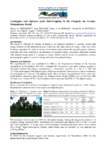Use este identificador para citar ou linkar para este item:
http://www.alice.cnptia.embrapa.br/alice/handle/doc/1036760| Título: | Eucalyptus and digitaria grass intercropping in the Chapada do Araripe, Pernambuco, Brazil. |
| Autoria: | DRUMOND, M. A.  RIBASKI, J.   MORAES, S. A. de   OLIVEIRA, V. R. de   TAVARES, J. A.   VOLTOLINI, T. V.   |
| Afiliação: | MARCOS ANTONIO DRUMOND, CPATSA; JORGE RIBASKI, CNPF; SALETE ALVES DE MORAES, CPATSA; VISELDO RIBEIRO DE OLIVEIRA, CPATSA; José A. Tavares, Instituto Agronômico de Pernambuco (IPA); TADEU VINHAS VOLTOLINI, CPATSA. |
| Ano de publicação: | 2015 |
| Referência: | In: WORLD CONGRESS ON INTEGRATED CROP-LIVESTOCK-FOREST SYSTEMS; INTERNATIONAL SYMPOSIUM ON INTEGRATED CROP-LIVESTOCK SYSTEMS, 3., 2015, Brasília, DF. Towards sustainable intensification: proceedings. Brasília, DF: Embrapa, 2015. |
| Conteúdo: | The region of Chapada do Araripe, in Brazil, is an important producer of gypsum, having high energy demand for the industrial process. Currently, the main source of energy is the wood from Caatinga vegetation. In order to reduce deforestation and promote the regional gypsum industry, eucalyptus has been indicated as an alternative to generate energy. Eucalyptus integrated systems with adapted forage plant is a strategy to ensure stability and diversify the production systems, increasing the supply of wood for energy and fodder for animal feeding. |
| Thesagro: | Floresta Caatinga |
| NAL Thesaurus: | Eucalyptus |
| Palavras-chave: | ILPF Chapada do Araripe Polo Gesseiro Caatinga vegetation Forest |
| Tipo do material: | Resumo em anais e proceedings |
| Acesso: | openAccess |
| Aparece nas coleções: | Resumo em anais de congresso (CPATSA)  |
Arquivos associados a este item:
| Arquivo | Descrição | Tamanho | Formato | |
|---|---|---|---|---|
| Drumond2015.pdf | 168,53 kB | Adobe PDF |  Visualizar/Abrir |









